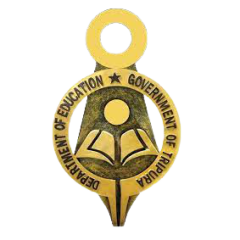The history of modern education of Tripura begins with the inception of Umakanta Academy. With this school, the light of knowledge started to illuminate the darkness of ignorance in the princely state of Tripura in the era of pre-independence.
Though the exact Foundation Day of this prime school of the state isn’t clearly defined, but the researchers found enough hints in the memoir book of the second son of the king Ishan Chandra Manikya, Nabadwip Chandra Debbarma (father of legendary music composer Sachin Debbarman) named ‘Abarjanar Jhuri’,to conclude into certainty that this school was established in the latter half of December 1862 by the King Birchandra Manikya. It was established mainly for the education of the boys from the relatives of the king and the royal officials, so that could take over the administrative posts by way of inheritance.
When the first Political Agent A.W.B. power paid his introductory visit at Agartala on 1st August 1871, he found the school in conformity with the British standard of Middle English (Class VI) School with four teachers, two for English, and two for Bengali and Sanskrit. The Agents made relentless efforts to impose the quality of education in the school and mainly due to them the school was upgraded to an Entrance School in the year 1890 when Babu Umakanta Das, the former Assistant Political Agent was the Minister of Tripura. Earlier not many of the students could avail the opportunity of higher education outside the state after completion of the sixth standard study in the school. As the only entrance school of the entire state for several decades, it played a pivotal role in spreading of higher education in the state as many of the divisional schools acted as feeder schools to this institution before they got affiliation of Calcutta University to become independent entrance schools.
At the time of origination the school was known as ‘Maharajoli Natun Haveli English School’ which was later, after attaining High School status in 1890 was renamed as ‘Agartala High School’. Afterwards in the year 1905 (29th Falgun, 1314, Tripura Era) the school was retilted as ‘Umakanta Academy’ by memo no.14 of Tripura Gazette. In the year 1959 it was upgraded into a Higher Secondary (Class XI) school. In the year 1957, the school was elevated to a multipurpose school with different facilities including stenography, technology etc., with general curriculum. In 1976 it came under Tripura Board of Secondary Education as a XII class school. Computer education at base level was also introduced in the school.
The performance of the institution was always highly praiseworthy during the aeon of princely Tripura and also after independence it is continuing its journey at the same pace. It has produced innumerable individuals who contributed and are contributing significantly in different fields including music and culture in-side and out-side the state.
The Centenary Celebration as a High School was commemorated on 15th December 1990 in presence of the then Hon’ble President of India, R. Venkataraman.
Vision: To transform the school to a place where students and teachers continually expand their capacity to create the results they truly desire, where new and expansive patterns of thinking are nurtured, where collective aspiration is set free, and where teachers and students are continually learning to see the whole together.
Mission: We strive to prepare all students to become lifelong learners and responsible citizens ready to face every challenges of the future. Our Mantra is- EVERY STUDENTS LEARNS, GROWS EVERYDAY IN EVERY CLASS. In connection with families and communities, our goal is to create a relevant learning opportunities for students inside the classroom- which can help them develop knowledge, critical thinking skills, and character necessary to succeed in an ever-changing world.
Other information
- Affiliation: CBSE (pending)
- School UDISE Code: 16010102103
- Medium of Instruction: Bengali; English (second language), Sanskrit (optional)
- Classes I to XII
